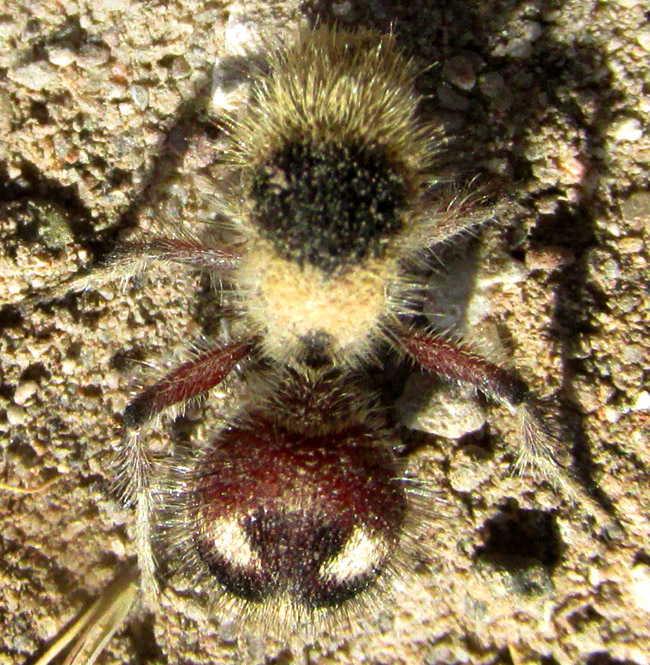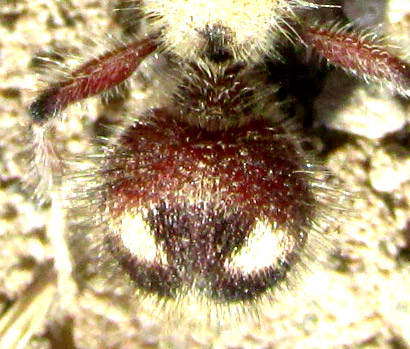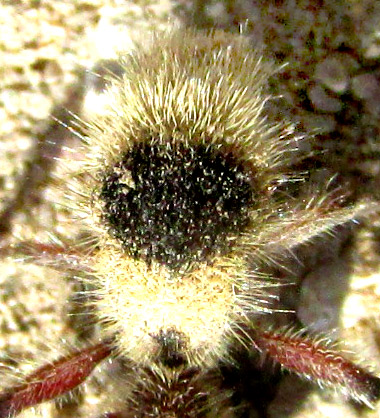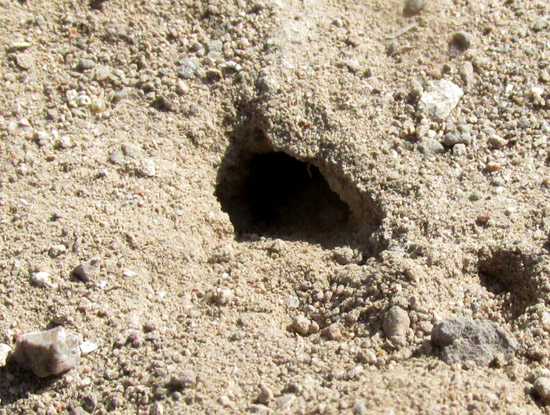Excerpts from Jim Conrad's
Naturalist Newsletter
Entry dated April 15, 2024, issued from near Tequisquiapan,Querétaro state; long-overgrazed field with areas void of vegetation exposing naked dirt composed of fragmented volcanic tuff, or ash of varied particle size; elevation about 1,900m, (6200 ft), ~N20.57°, ~W99.89°; MÉXICO
DASYMUTILLA SICHELIANA

The hairy creature seen above rushed across the hot sand fast and seemingly randomly, exactly in the manner I'm used to for velvet ants, which are wingless wasps with respectable stings. Most velvet ants seen in this area are red and black, so this must have been a different species. However, once the above picture was on my laptop's screen, I wasn't sure what it was.
Is the head at the top or bottom of the above picture? At the bottom, it looks like two thick pincers on the head of a really big ant, but where are the eyes and antennae? And if it's a wasp, where is its diagnostically threadlike "wasp waist"? Could this even be some kind of tarantula? No, because spiders and tarantulas bear eight legs while this has six.
Assuming it was a velvet ant (wasp), at the iNaturalist.Org website I scanned hundreds of images from Mexico of species in the Velvet Ant Family, the Mutillidae, and saw nothing like our creature. After repeating that search three times, looking harder each time, finally I noticed one picture in which one end of the body was at least somewhat like the bottom end in our picture. That image was part of a series of pictures of the same individual, but in this particular image the wasp was curving its rear end, or abdomen, underneath itself. Apparently this was because it felt threatened as the photographer drew closer; I'd gotten pretty close, too.

At the right is a close-up of our critter's abdomen, the bottom, from a picture taken farther away, when the insect was less nervous and less humped up. In this more relaxed state the slender "wasp waste" is more evident. What appear to be pincers reveal themselves as color patterns on the rounded abdomen's hairs, most hairs being black on the bottom and top, and white in the middle. From our angle of observation an optical illusion is achieved; nothing there like pincers exist. This is another reason why the wasp would benefit from curving its body, for the illusion is much less convincing, or suggested at all, when the body is normally extended.

At the left, the top end of our less-extended individual is seen closer up. At the picture's top, note that more of the less-downcurved thorax's white hair tops are visible than in our first picture. Even still, the insect's entire head is bent so low that it's obscured from our vision.
If there's a head down there, where are the antennae? When I returned to those iNaturalist.Org pictures for a fourth time, finally I noticed a picture of one of the same species hunched up a little, with his antennae held backward so close to the body that when viewed from above they're hidden below the long hairs. Having no antennae furthers the illusion of the rear end being a head bearing dangerous-looking pincers.
Once I'd penetrated these illusions, other of our individual's features fell into place. The chestnut-colored abdomen body surface contrasted with the black splotch on the thorax, and the legs' chestnut-colored and particularly thick segments nearest the body, the femurs, all matched iNaturalist.Org pictures identified as DASYMUTILLA SICHELIANA.
Dasymutilla sicheliana is known by no English name. It lives in arid and semiarid environments from a small part of southern Arizona in the US, south in western and central Mexico to Oaxaca state.
I find little information about this species; certainly nothing about the behavior and illusions described above, and which I add to here:

At the right is the hole into which our velvet ant escaped when I got too close. The individual seemed to know exactly where the hole was, went straight for it and dove right in. Something must have been blocking the hole, possibly the gravel at the picture's lower, left, for quickly something was ejected powerfully enough to land well away. Also I can add that, judging from pictures on the Internet, there's a great deal of color pattern variation in this species.
While little is known about the behavior of Dasymutilla sicheliana, considerable study has been done on the genus Dasymutilla, for its 41 or so recognized species -- all native to the Americas -- fascinate researchers and everyone else.
For instance, their larvae are external parasites on various types of ground-nesting members of the bee/ant/wasp order the Hymenoptera. Also, their stings can be excruciatingly painful, though the painfulness varies with the species. Our Dasymutilla sicheliana is one of the genera's many species exhibiting Müllerian mimicry, in which two or more well defended species mimic one another's warning signals, to their mutual benefit. Our wasp, which looks like an ant, also looked like a honeybee with its stinger. Our wasp even went beyond that, with its fake pincers.
Sometimes when threatened, Dasymutilla species produce loud squeaking noises. And someone has even figured out that eleven times the force is needed to crush the exoskeleton of a female velvet ant than that of a honey bee.